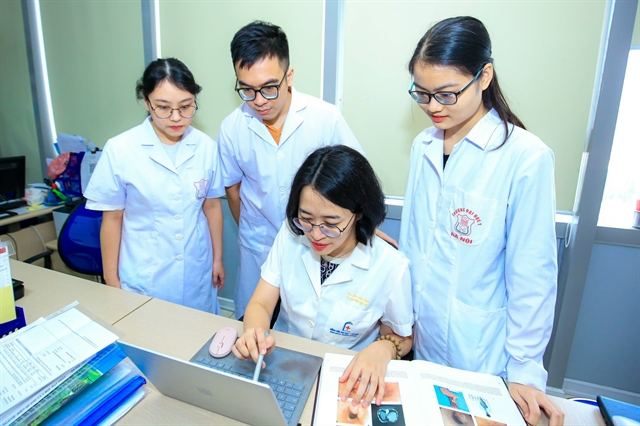 Society
Society

 |
| Dr Đào Việt Hằng (sitting) works with her colleagues. — Photo nhandan.vn |
Gastrointestinal Endoscopy (GE) is a special test to diagnose the condition of the upper digestive system. Dr Đào Việt Hằng, Vice Director of the Endoscopy Centre of Hà Nội Medical University Hospital, is looking at how to apply AI to GE procedures in Việt Nam.
In a recent interview with Nhân Dân (The People) newspaper, Dr Hằng talks about her ambition to add Việt Nam to the list of countries that apply AI to gastrointestinal endoscopy.
Why do you choose AI for medical tests, especially here for GE?
Five years ago, I attended American Digestive Disease Week and started to see research about AI applications in GE. At that time, I felt it was way too far for Việt Nam to have it.
When studying and researching in Japan, I did ask my supervisor: “Is there any chance a developing country like Việt Nam can apply AI given limited economic resources?”.
I received the answer: “Because it is a developing country, it has to apply AI. The GE test in the developed system which is well-invested, therefore, it is less likely to make mistakes. However, in the underdeveloped one, we need a tool to help doctors diagnose digestive problems more effectively from GE. Therefore, it is much needed in developing countries.”
This helped me understand that the fundamental of applying AI is for its benefits, not the need to have a huge investment in it.
We did have a survey in 2019 on how doctors may preserve AI and whether they would worry that AI will steal their job in the future.
However, we are surprised that 90 per cent of the doctors answered that they take AI as the tool for GE, and they need something like AI not just for assessing but directly in the GE procedure. This is our foundation for further research.
What are your difficulties in developing the Vietnamese AI model made by Vietnamese people?
We are researching and improving AI algorithms from Việt Nam medical database. We do it 100 per cent through Việt Nam’s endoscopy and IT specialists.
The medical database allows us to have diverse cases of condition and treatment, which can relate to similar cases in the future, and it will be applied directly to our medical treatments.
Our biggest difficulty is collecting, standardising and building the database. Việt Nam has many endoscope systems with different quality, light and resolution. However, we must ensure a diverse and standardised database to create patterns and train algorithms.
Another difficulty is to label the database and localise and evaluate the severity of injuries uniformly among medical professionals. It requires great effort and time from our endoscopy experts.
What have you and your team been doing applying AI to medical procedures?
Currently, we have two projects. One is to build an algorithm for detecting colon polyps, classifying if it is harmful or harmless. The project is expected to take place in two and a half years and has completed building the algorithm based on large data collected in Việt Nam and is already labelled by endoscopy experts.
The second is to build an algorithm for detecting lesions in the upper digestive system. There are five types of lesions, so it takes longer to form the database. We expect to do it within three to three and a half years under the KC 4.0 programme of the Ministry of Science and Technology.
How can Việt Nam go further in applying AI in medicine?
AI can be approached in many ways for medicine. Some teams use big data for diagnostic models or building models in the prognosis of response to treatment. The speciality of diagnostics or GE is an image, therefore database used for the algorithm is images. For diagnostics through images, we have seen the huge advantages of AI in detecting lesions in X-rays, scanners and MRIs.
However, AI cannot replace doctors in GE since it is still an invasive procedure. Doctors are still the ones who directly conduct the GE and decide if the patient needs treatments. The purpose of AI is to assist the doctor in minimising making mistakes and acting as the reference for any of their decision.
I hope there will be more AI applications like that in the medical field in the future. As for now, with the existing application, I am sure AI will help reduce investment resources and help doctors spend more time on the procedure instead of the usual diagnosis like now.
What is your motivation to do this project and to ensure its success?
With projects having an interdisciplinary nature, teamwork is very important. It took our research team six months to find a common language between GE and IT specialists.
For the IT team, it is difficult to understand the medical terms, names of anatomical locations, which images are normal, and where lesions are. But you need to understand all the terms to build a model that can bring optimal efficiency.
Convincing the medical team to join the project alone is difficult. Because they have to spend more time on their own identifying and localising the lesions on images for the database.
Once we have the first algorithm, we must check the accuracy so they can learn and optimise further. The role of the medical team is undeniably very crucial.
The most difficult thing for us is to find a common voice. However, in the project, we also get the very great joy.
Sometimes we are happy when our patients ask: “Doctor, I heard that you are doing AI in GE. When can I get my GE with AI? Is AI going to help detect problems during GE better?”. VNS




